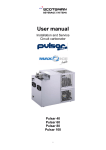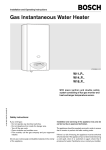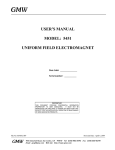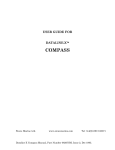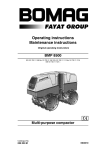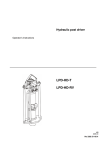Download Atlas Copco LP 13-20 DEL PAC Operating instructions
Transcript
LP 13-20 DEL PAC ATLAS COPCO CONSTRUCTION TOOLS AB NACKA • SWEDEN www.atlascopco.com 2007-03 No. 3392 5146 01 1 English !" !" INTRODUCTION ....................................................................................................................... 2 SAFETY INSTRUCTIONS ........................................................................................................ 2 Introduction to safety ....................................................................................................... 2 Safety symbols used ........................................................................................................ 2 General safety rules.......................................................................................................... 3 Protective equipment........................................................................................................ 3 MARKINGS ............................................................................................................................... 4 Identification ...................................................................................................................... 4 CE ....................................................................................................................................... 4 Safety signs on the Power Pack ...................................................................................... 4 GENERAL INFORMATION....................................................................................................... 4 Parts identification ............................................................................................................ 5 OPERATING INSTRUCTIONS ................................................................................................. 6 Preparation before starting .............................................................................................. 6 Starting the engine (electric start)................................................................................... 7 Starting the engine (recoil start)...................................................................................... 7 Stopping the engine.......................................................................................................... 7 Hydraulic control and connectors................................................................................... 8 Connecting/disconnecting hoses ................................................................................... 8 How to check the hydraulic system ................................................................................ 9 Service schedules............................................................................................................. 9 Scrapping and waste disposal ...................................................................................... 10 TROUBLESHOOTING ............................................................................................................ 11 TECHNICAL DATA ................................................................................................................. 12 English 2 !"# $ " ! These operating and safety instructions must be read before operating the machine. Instructions for operation and basic maintenance are included. The purpose of this booklet is to give the machine user an understanding of how to safely and efficiently use and maintain the machine. % "& ! "#$ " ! SAFETY INSTRUCTIONS • Before starting, read all instructions carefully • Special attention must be paid to information alongside this symbol • Only use Atlas Copco genuine parts To reduce the risk of serious injury to yourself or others, read these safety instructions before using the Power Pack. Post these safety instructions at work locations, provide copies to employees, and make sure that everyone reads the safety instructions before using the Power Pack. Comply with all safety regulations. These instructions have been compiled from international safety standards and form part of the operating instructions. Signs and decals that are important for your safety and the care of the Power Pack are included with each power pack. Make sure that they are legible. New decals can be ordered using the spare parts list. '( ) The indications DANGER, WARNING and CAUTION, as used in the safety instructions, have the following meanings: DANGER Immediate hazard which WILL result in serious or fatal injury if the warning is not observed WARNING Hazard or hazardous procedure which COULD result in serious or fatal injury if the warning is not observed CAUTION Hazard or hazardous procedure which COULD result in injury or damaged equipment if the warning is not observed 3 English * • • • • • • • • • • • ) ) The Power Pack and accessories must only be used for their purpose Learn how the Power Pack is switched off in the event of an emergency Only qualified and trained persons may operate or maintain the Power Pack Keep the Power Pack in a safe place out of the reach of children, locked up Pay attention and look at what you are doing Use your common sense Do not use the Power Pack when you are tired or under influence of drugs, alcohol or anything else that may influence your vision, reaction or judgement Never leave the Power Pack turned on Avoid lifting a higher weight than that allowed according to your local environmental working regulations Regular maintenance is prerequisite for machine safety. Carefully follow the operating instructions. Replace damaged and worn components in good time. For major service to the Power Pack, contact your nearest authorized workshop. When cleaning mechanical parts with solvent, make sure to comply with current health and safety regulations and ensure sufficient ventilation Breathing the Power Pack’s exhaust gases can harm and possibly kill you. Do not start or run the Power Pack in enclosed areas, even if the doors and windows are open. Start and run the Power Pack outdoors. WARNING The engine exhaust from this product contains chemicals. These chemicals could cause cancer, birth defects or other reproductive harm. Start and run the Power Pack outdoors. • Explosions and fire can be caused by sparks from the exhaust or the electrical system. Do not use the machine in closed areas with flammable material, vapour or dust. + , ' Always use approved personal protective equipment. Operators and other staff in the proximity areas where work is in progress must as a minimum use the following approved protective equipment: • Hearing protection When the Power Pack is used as a power source for breakers, cut-off saws and similar tools, use the following personal protective equipment: • • • • • Protective helmet Safety glass with side protection Respiratory protection when appropriate Protective gloves Protective boots English 4 - #. !* The Atlas Copco LP 13-20 DEL PAC fulfils all safety regulations in the Directive 98/37/EC. The Atlas Copco LP 13-20 DEL PAC does not comply with the regulations in the Directive 2000/14/EC with regard to noise. The Atlas Copco LP 13-20 DEL PAC has therefore no CE marking. The Atlas Copco LP 13-20 DEL PAC is therefore not approved for use on the EU market. / * ! # !% #- " ! The Atlas Copco LP 13-20 DEL PAC is a hydraulic Power Pack designed for operating Atlas Copco hydraulic breakers and other tools. The Power Pack is fitted with a 10 HP Lombardini, air cooled, 1 cylinder 4-stroke diesel engine with electric start. The flow of the LP 13-20 DEL PAC is 20 l.p.m. 5 English 1 Filler cap, fuel 11 Hydraulic pump 2 Filler cap, hydraulic oil 12 Recoil start 3 Sight glass, hydraulic oil level 13 Pressure relief valve 4 Filter condition gauge 14 Foldable handles 5 Hydraulic oil filter 15 By-pass valve 6 Engine oil, dipstick 16 Air filter 7 Starting switch 17 Drain plug 8 Ignition switch OFF and ON 18 Battery 9 Stop lever 19 Throttle lever 10 Oil cooler English 6 # " !* ! "#$ " ! ( The following checks should be made each time you return to the Power Pack after leaving it for a period of time. All these checks concern the serviceability of the Power Pack. Some concern your safety. • • • • • • • • • • Remove dirt and debris especially from around the linkage and hydraulic oil cooler Clean all safety decals. Replace any that are missing or cannot be read Inspect the Power Pack and hoses generally for signs of damaged and missing parts Check for fluid and fuel leakages beneath the Power Pack Check the security of the hinged frame Make sure the fuel filler cap is tightly closed Check the hydraulic oil level and add as necessary Position the Power Pack in a safe position Ensure that the hydraulic couplings are clean and fully serviceable Ensure that any hydraulic tool you plan to use is compatible with the model of the Power Pack you are using. See the section Flow rates Check the engine oil level and add oil as necessary Ensure that you have adequate fuel for the job. Top up as necessary, taking care not to overfill • • WARNING • Diesel and its vapours are flammable and explosive. Fire or explosion can cause severe burns or death • Keep naked flames away from the Power Pack • Do not smoke while refuelling the Power Pack or working with the engine • Do not refuel with the engine running. Turn off the engine and let the engine cool before refuelling • Do not overfill the tank beyond the top of the red plug inside the fuel tank filter 7 English / ) 1. Set the hydraulic by-pass valve (A) in the OFF position 2. Set the engine speed lever (C) in the START position 3. Turn the starting key (D) clockwise to the START position 4. Push the start button (E) for a few seconds 5. Remove your hand from the button, as soon as the engine starts CAUTION In order not to damage the starter, do not activate the starter for more than 10 seconds. Wait for about 15 seconds before the next try. 6. Let the engine warm up without load for about 3 minutes / 0 ) 1. Set the hydraulic by-pass valve (A) in the OFF position 2. Set the engine speed lever (C) in the START position 3. Take the recoil handle (12) and pull the rope softly until it is extended to its full limit. 4. Let the rope rewind completely. 5. Start the engine by pulling the rope strongly . CAUTION Do not allow the recoil starting handle (12) to snap back against the engine. Return it gently to prevent damage to the starter. WARNING Never use any cold-starting aids such as ether, gasoline, paint thinner or other volatile liquid or gas. 6. Let the engine warm up without load for about 3 minutes / 1. Turn the hydraulic by-pass valve (A) to the OFF position 2. Move the throttle lever (C) to the low speed position and let the engine run for about 3 minutes without load 3. Move the throttle lever (H) to the STOP position 4. Turn the ignition key (D) counter clockwise to the OFF position 5. Slowly pull out the recoil starting handle (12) until resistance is felt and leave the handle in this position. This prevents rust from forming while the engine is not in use A H C E D pe English 8 CAUTION H When stopping the engine, reduce the load slowly. Do not stop the engine suddenly since it may cause the temperature to rise abnormally. 1 ) a) Attach the return line b) Attach the feed line c) Rotate the collar on the female coupling to secure the coupling 4. Connectors (G) and (H) are used to connect the Power Pack to the tool as follows: Connector (G) Return (female) Connector (H) Feed (male) 1. Prepare the Power Pack a) Turn the by-pass valve to the OFF position b) Stop the engine 2. Remove the hoses a) Rotate the collar on the female coupling b) Release the return line c) Release the feed line / Ensure that any tool you plan to use is compatible with the model of the Power Pack you are using. Non-compatible tools might harm both the Power Pack and the tools. Check the section Flow rates in this instruction book and compare the flow rate with the technical specifications in the instruction book for the tool. Check the hydraulic oil level a) Start the engine and run the Power Pack to fill up the hydraulic circuit b) Check the hydraulic oil level Disconnecting hoses 2 CAUTION On G ) The by-pass valve (F) shall be in the OFF position when starting and in the ON position when using the tool. • • F Off Note: The couplings are unlocked by moving the collar back on the coupling WARNING Do not disconnect the hoses when the Power Pack is running or if the hydraulic oil is hot. Hot hydraulic oil might cause serious burns. Connecting hoses 1. Prepare the Power Pack a) Turn the by-pass valve to the OFF position b) Stop the engine 2. Inspect the couplings a) Ensure that the couplings are clean and serviceable 3. Connect the hoses 9 English Note: The inaccuracy of the reading on the flow meter is ±2 l.p.m. (±0.5 gal/min). If the performance is not in accordance with the technical specifications for the Power Pack, please see the section TROUBLE SHOOTING 0-250 bar (0-3600 psi) 5-46 l/min. (1-12 gal/min.) + / ) A poorly maintained Power Pack is a hazard. Doing regular maintenance and lubrication jobs as listed in these schedules will help keep the Power Pack in a safe working condition. 1 / / / ) ' To set or check the oil flow and the pressure relief valve we recommend using the Atlas Copco test equipment or similar test equipment. Apart from the daily jobs, the schedules are based on the operation hours of the Power Pack. Keep a regular check of hours in use. Do not use a Power Pack that is due for regular service. Rectify any defects found during regular maintenance before clearing the Power Pack for use. Part number 3371 8011 54 How to check 1. Stop the engine (see the section Stopping the engine) 2. Connect the test equipment to the Power Pack. Male (B) to the return connection and female (A) to the feed connection on the Power Pack. Make sure that the loading valve of the test equipment is fully open 3. Start the engine (see the section Starting the engine – electric start) 4. Move the by-pass valve on the Power Pack to the ON position 5. Turn the loading valve, until the gauge shows approx. 70 bar (1000 psi) and allow the Power Pack to warm up for 3-4 minutes 6. Slowly close the loading valve until the pressure gauge shows the nominal pressure according to the technical specifications 7. Check that the flow is according to the flow rate in the technical specifications WARNING Maintenance must be done only by suitably qualified and competent persons. Before doing any maintenance, make sure that the Power Pack is safe and correctly sited on level ground. Daily 1. 2. 3. 4. 5. 6. 7. 8. Clean the Power Pack in general Check fuel lines, tank, fuel cap and fittings for cracks or leaks. Replace if necessary Check for damages Check hydraulic fluid level Check engine oil level Check hydraulic couplings Check hydraulic hoses Check hydraulic oil filter English 10 IMPORTANT When the filter gauge needle remains in the red sector (while the engine is running idle and the oil is service warm), the filter must be replaced. The old filter is removed by turning it clockwise (use a filter strap wrench if necessary). Tilting the Power Pack rearwards will minimise oil spilling. Before mounting the new filter, it is recommended to grease the surface of the seal with oil in order to ease correct tightening of the filter. Every 3 months 1. 2. 3. Do the daily jobs Check tightness of nuts, bolts, screws and hose fittings Clean the air cleaner element (see engine manufacturer’s handbook) Every 300 hours or every year 1. 2. 3. Do the daily jobs and jobs every 3 months Change the hydraulic oil Change the hydraulic oil filter ) WARNING Fine jets of hydraulic oil at high pressure can penetrate the skin. Do not use your fingers to check for hydraulic oil leaks. Do not put your face close to suspected leaks. Hold a piece of cardboard close to suspected leaks and then inspect the cardboard for signs of hydraulic oil. If hydraulic oil penetrates your skin, get medical help quickly. Note: Check tightness of nuts, bolts, screws and hose fittings after the first days of operation and thereafter in accordance with the maintenance schedule Note: The engine oil should be replaced after the first 8 hours of operation and thereafter in accordance with the maintenance schedule in the engine manufacturer’s operating and maintenance instructions Used and worn out parts must be treated and disposed of in such a way that the greatest possible part of them can be recycled and the influence on the environment kept as low as possible 11 English "# $3 1 " !* WARNING Maintenance must be done only by suitably qualified and competent persons. Problem Cause Solution Engine turns over but does not start No fuel Top up tank Fuel line blocked Clear line Fuel filter is taped Change the fuel filter Engine malfunction Refer to engine manual By-pass valve in the ON position Turn valve to OFF Engine malfunction Refer to engine manual Battery uncharged Start engine with recoil start or recharge battery Damaged hoses Check and replace if needed Leaking connections Check for tightness/leaks Defect hose couplings Replace couplings Low pressure relief valve setting Adjust valve High back pressure Check hose system for blockage Worn hydraulic pump Replace pump Engine does not turn over or is difficult to turn Low hydraulic oil level Poor tool performance English 12 Problem Cause Solution Frothy or creamy coloured hydraulic oil Air or water in oil Check for loose connections on line to pump Make sure that the filler cap on the tank is not loose Check that oil level is at the top of the sight glass Tool runs hot Power Pack stops suddenly " 1! Poor siting of Power Pack causing warm air to recirculate Resite Power Pack for free air circulation Blocked oil cooler Blow cooler clean. NEVER use a wire brush Defect fan Replace fan Back pressure too high Check hose system Tool defect Check and service tool Out of fuel Top up tank " Dimensions Engine type Engine Lombardini, air cooled, 1 cylinder 4-stroke diesel engine with electric start Performance 10 HP (7.5 kW) at 3600 rpm Fuel Diesel Starter Electric start and recoil hand start Hydraulic system Height (A) Width (B) Length (C) Weight with oil 705 mm (27.7”) 600 mm (23.6”) 745 mm (29.3”) 116 kg (256 lbs) Circuit type Open centre Pump type Gear pump, directly driven from the engine crankshaft by means of a flexible coupling Filtration 25µ filter in return line. Filter by-pass valve in valve block Cooling system Thermostatically controlled air blast oil cooler 13 English IMPORTANT Fluids, lubricants, capacity and specification Item Capacity The torque of the engine is reduced when reducing the rpm. The Power Pack can therefore not in all cases deliver the maximum pressure at low rpm. Fluid/lubricant Litres (gal,US) Engine (oil) Refer to manufacturer’s operating and maintenance instructions. Fuel tank 5 (1) Hydraulic fluid 7 (1.85) Diesel, cetan value more than 45 Mobil EAL 224 or similar Hose length 1 In normal ambient temperature, 040°C (32-104°F), the maximum hose length should not exceed 25 m (82 ft) Flow rates 2 The European Hydraulic Tool Manufacturers Association (E.H.T.M.A.) has categorised hydraulic power packs and tools in terms of flow rate and working pressure. Normally, 7 m of Twin hoses are to be used for the Power Pack. Twin hose and other accessories are shown in the spare parts list. Our LP 13-20 DEL PAC is categorised by the E.H.T.M.A. as below: Flow rate, l.p.m. (gal,US) Nominal pressure, bar (psi) Max. pressure, bar (psi) E.H.T.M.A. category Note: 20 (5) 120 (1800) 140 (2000) C Atlas Copco hydraulic power packs are clearly marked with E.H.T.M.A. categories. It is important that any tool used with the Power Pack is of a compatible category. If any doubt, consult your Atlas Copco dealer. WARNING The setting of the pressure relief valve on the Power Pack can in some cases be higher than the prescribed max. pressure according to the E.H.T.M.A. category. A too high pressure relief valve setting can harm the tool. Readjust the pressure relief valve on the Power Pack if the technical specifications of the tool prescribe a lower pressure relief valve setting than the standard setting of the Power Pack.

















